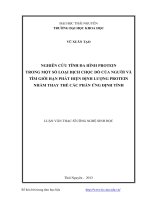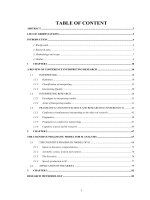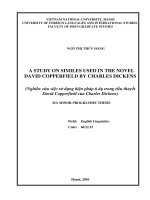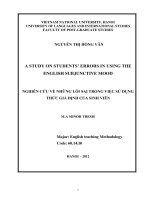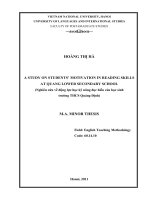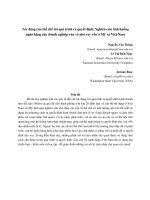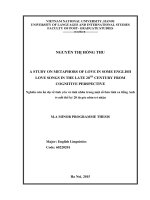CASE STUDY GENDERED SPEECH DIFFERENCES IN THE AMERICAN MASTERCHEF EPISODE 1 SEASON 6 = NGHIÊN cứu TÌNH HUỐNG NHỮNG sự KHÁC BIỆT TRONG DIỄN NGÔN KHÁC GIỚI TRONG CHƯƠNG TRÌNH VUA đầu bếp mỹ mùa 6 tập 1
Bạn đang xem bản rút gọn của tài liệu. Xem và tải ngay bản đầy đủ của tài liệu tại đây (1.45 MB, 80 trang )
VIETNAM NATIONAL UNIVERSITY, HANOI
UNIVERSITY OF LANGUAGES AND INTERNATIONAL STUDIES
FACULTY OF LINGUISTICS & CULTURES OF
ENGLISH-SPEAKING COUNTRIES
GRADUATION PAPER
CASE STUDY: GENDERED SPEECH DIFFERENCES
IN THE AMERICAN MASTERCHEF EPISODE 1
SEASON 6
Supervisor: Vũ Minh Huyền
Student: Bùi Thị Anh Thư
Course: QH2017.F1.E22.PDCLC
Hanoi – 2021
ĐẠI HỌC QUỐC GIA HÀ NỘI
TRƯỜNG ĐẠI HỌC NGOẠI NGỮ
KHOA NGƠN NGỮ VÀ VĂN HĨA CÁC NƯỚC NĨI TIẾNG ANH
KHĨA LUẬN TỐT NGHIỆP
NGHIÊN CỨU TÌNH HUỐNG: NHỮNG SỰ KHÁC
BIỆT TRONG DIỄN NGƠN KHÁC GIỚI TRONG
CHƯƠNG TRÌNH VUA ĐẦU BẾP MỸ MÙA 6 TẬP 1
Giáo viên hướng dẫn: Vũ Minh Huyền
Sinh viên: Bùi Thị Anh Thư
Khóa: QH2017.F1.E22.PDCLC
HÀ NỘI – 2021
Signature of Approval:
_____________________________________________________________
_____________________________________________________________
_____________________________________________________________
_____________________________________________________________
_____________________________________________________________
_____________________________________________________________
ACCEPTANCE PAGE
I hereby state that I: Bùi Thị Anh Thư, QH.2017.F1.E22.PDCLC, being a
candidate for the degree of Bachelor of Arts accept the requirements of the College
relating to the retention and use of Bachelor’s Graduation Paper deposited in the
library.
In terms of these conditions, I agree that the origin of my paper deposited in
the library should be accessible for the purposes of study and research, in accordance
with the normal conditions established by the librarian for the care, loan or
reproduction of the paper.
Signature
Date: 04/05/2021
ACKNOWLEDGEMENTS
For the completion of my graduation thesis, I would like to express my
deepest gratitude to those who offered me great help throughout the process.
Without their support, it was impossible for me to complete this graduation paper
on my own.
First and foremost, I would like to sincerely thank Ms. Vu Minh Huyen, my
supervisor, for her thorough guidance, constructive comments and constant
encouragement. She has been an incredible supporter, who has not only instructed
me throughout the research, but has also been the one that sparkled my interest in
Linguistics in the first place.
Secondly, I am also extremely thankful to Ms. Nguyen Thi Minh Tam, the
Dean of the Faculty of Linguistics and Cultures of English Speaking Countries for
her careful reminders with detailed schedules, as well as her heartfelt suggestions
for every from minor to major problems I encountered.
Thirdly, I hope to give thanks to the members of the University of Languages
and International Studies’ libraries for providing me with all the well-equipped
facilities and adequate materials for the need of my research.
Last but not least, I am very grateful to my family and all of my friends for
always believing in me and encouraging me to overcome every hardship I might
face.
i
ABSTRACT
Gender difference in communication has been a topic of debate over the past
few decades and in fact, there has been no sign of it being diminished but increased
significantly throughout the years. A number of studies into gender differences in
daily conversations, academic learning environments and TV series were
conducted. Nevertheless, few studies have been recognized towards the famous
reality show “American MasterChef”. Therefore, this case study was carried out in
order to examine the gendered speech differences delivered by male and female
judges in the American MasterChef episode 1 season 6 considering 4 main
elements: sentence types, tentative speech forms, vocal tendency, and speech acts.
Data was collected and put under close observation with frequency analysis.
The results showed that, as regards to sentence types, women used more declarative
and interrogative sentences when giving comments and making requests to the
contestants, whereas men preferred imperatives. In addition to that, despite a small
difference between the two genders’ frequency, women did surpass men in the use
of three tentative speech forms i.e. intensifiers, hedges, and back-channels.
Regarding vocal tendency, the male judge overall spoke faster yet at a lower pitch
and delivered more information compared to their female counterpart. Lastly, the
study’s findings concluded that both men and women equally favored direct speech
acts over indirect speech acts in their conversations.
ii
TABLE OF CONTENTS
ACKNOWLEDGEMENTS ................................................................................... i
ABSTRACT ............................................................................................................ ii
TABLE OF CONTENTS ..................................................................................... iii
LIST OF TABLES & FIGURES ......................................................................... vi
CHAPTER 1: INTRODUCTION ......................................................................... 1
1.1.
Background of the study ...................................................................................... 1
1.2.
Statement of research problem & questions ......................................................... 2
1.3.
Scope of the study ................................................................................................ 2
1.4.
Significance of the study ...................................................................................... 3
1.5.
Organization ......................................................................................................... 3
CHAPTER 2: LITERATURE REVIEW............................................................. 5
2.1.
Gender .................................................................................................................. 5
2.2.
The American MasterChef reality show .............................................................. 5
2.2.1
Reality television shows ............................................................................................... 5
2.2.2
The American MasterChef........................................................................................... 6
2.3.
Linguistic features ................................................................................................ 8
2.3.1
Sentence types ................................................................................................................. 8
2.3.1.1
Declarative sentences ................................................................................................ 8
2.3.1.2
Interrogative sentences ............................................................................................. 9
2.3.1.3
Imperative sentences ................................................................................................. 9
2.3.2
Tentative speech forms .............................................................................................. 10
2.3.2.1
Intensifiers ................................................................................................................. 10
2.3.2.2
Back-channels .......................................................................................................... 11
2.3.2.3
Hedges ........................................................................................................................ 13
2.3.3
Vocal tendency ............................................................................................................. 14
2.3.3.1.
Speed........................................................................................................................... 14
2.3.3.2.
Intonation ................................................................................................................... 15
2.3.4.
Direct & Indirect Speech acts .................................................................................. 16
CHAPTER 3: METHODOLOGY...................................................................... 18
3.1
Research design and Sampling method .............................................................. 18
3.2
Data collection instrument ................................................................................. 18
iii
3.3
Data collection procedure................................................................................... 19
3.4
Data analysis procedure ..................................................................................... 19
CHAPTER 4: DATA ANALYSIS AND DISCUSSIONS ................................. 21
4.1
Sentence types .................................................................................................... 21
4.1.1
Declarative sentences ................................................................................................. 21
4.1.1.1
Findings...................................................................................................................... 21
4.1.1.2
Discussions ............................................................................................................... 21
4.1.2
Interrogative sentences............................................................................................... 22
4.1.2.1
Findings...................................................................................................................... 22
4.1.2.2
Discussions ............................................................................................................... 23
4.1.3
Imperative sentences................................................................................................... 24
4.1.3.1
Findings...................................................................................................................... 24
4.1.3.2
Discussions ............................................................................................................... 25
4.2
Tentative speech forms....................................................................................... 25
4.2.1
Intensifiers ..................................................................................................................... 25
4.2.1.1
Findings...................................................................................................................... 25
4.2.1.2
Discussions ............................................................................................................... 26
4.2.2
Back-channels............................................................................................................... 27
4.2.2.1
Findings...................................................................................................................... 27
4.2.2.2
Discussions ............................................................................................................... 28
4.2.3
Hedges ............................................................................................................................ 28
4.2.3.1
Findings...................................................................................................................... 28
4.2.3.2
Discussions ............................................................................................................... 29
4.3
Vocal tendency ................................................................................................... 29
4.3.1
Speed ............................................................................................................................... 29
4.3.1.1
Findings...................................................................................................................... 29
4.3.1.2
Discussions ............................................................................................................... 30
4.3.2
Intonation ....................................................................................................................... 31
4.3.2.1
Findings...................................................................................................................... 31
4.3.2.2
Discussions ............................................................................................................... 33
4.4
Speech acts ......................................................................................................... 33
4.4.1
Findings .......................................................................................................................... 33
4.4.2
Discussions .................................................................................................................... 34
CHAPTER 5: CONCLUSION ............................................................................ 36
iv
5.1
Summary of findings .......................................................................................... 36
5.2
Implications ........................................................................................................ 36
5.3
Limitations and suggestions for further research ............................................... 37
REFERENCES ..................................................................................................... 38
APPENDICES ...................................................................................................... 46
APPENDIX 1: TRANSCRIPTION AND COLOR CODED ELEMENTS ................. 46
APPENDIX 2: TYPES OF BACKCHANNELS .......................................................... 67
APPENDIX 3: SPEECH ANALYZER ........................................................................ 69
v
LIST OF TABLES
Table
Page
Table 3.1. Features and Classifications
19, 20
Table 4.1. Frequency of declarative sentences used by the judges
Table 4.2. Frequency of interrogative sentences used by the judges
Table 4.3. Frequency of imperative sentences used by the judges
Table 4.4. Frequency of intensifiers used by the judges
21
22, 23
24
25, 26
Table 4.5. Frequency of back-channels used by the judges
27
Table 4.6. Frequency of hedges used by the judges
28
Table 4.7. Number of words spoken per seconds by the judges
30
Table 4.8. Frequency of speech acts (direct and indirect) used by
the judges
33
LIST OF FIGURES
Figure
Page
Figure 4.1. Number of words spoken per seconds by the judges
30
Figure 4.2. Frequency of direct speech acts and indirect speech acts
used by the judges
34
vi
CHAPTER 1: INTRODUCTION
This chapter presents brief information of the research. This overview
includes 5 main points which are (1) background of the study, (2) statement of
research problem and questions, (3) scope of the study, (4) significance of the study,
and (5) organization of the study.
1.1.
Background of the study
Linguistics is the study of language and one of its branches is sociolinguistics
- the study of the correlation between social and linguistic variables. Before 1900,
the topic did not receive much attention as sociolinguists perceived male language
as the norm of language (Holmes, 2008). However, since the feminism movement
and the expansion of a wide range of studies on the differences between women’s
and men’s speech, the scope as well as the focus of language and gender research
have shifted significantly.
Robin Lakoff, known as the pioneer in this field, claimed that “there is a
discrepancy between English as used by men and by women; and that the social
discrepancy in the positions of men and women in our society is reflected in
linguistic disparities” (Lakoff, 1973). She concluded that women's speech is mostly
associated with expressions of uncertainty, rather than strong expressions, and often
in relation to “trivial” topics. In Language and Woman's Place (Lakoff, 1975), she
used several linguistic features namely lexical hedges or fillers, tag question, rising
intonation on declaratives, ‘empty adjectives, precise color terms, intensifiers such
as just and so, ‘hypercorrect’ grammar, ‘superpolite’ forms, avoidance of strong
swear words, and emphatic stress (as cited in Holmes, 2001) to differentiate between
women and men’s language characteristics. Lakoff held that men are more dominant
regarding social positions, while women lack power and authority. Despite being
criticized for frequent reliance on personal observation, feminist bias, and lack of
1
empirical data (White, 2003), Lakoff’s definition of woman’s language and position
has provided an initial theoretical framework for future researchers.
Nevertheless, all of the previous studies have not investigated into the
popular reality show - MasterChef U.S. Thus, this research is conducted to witness
“Gendered speech differences in the American MasterChef episode 1 season 6”
1.2.
Statement of research problem & questions
With the view to examining gendered speech differences in spoken data, the
study is going to analyze the show “American MasterChef” episode 1 season 6 in
2015 to seek the answers to the following question:
What are the gendered speech differences delivered by male and female
judges in the American MasterChef episode 1 season 6 regarding 4 main
elements: sentence types, tentative speech forms, vocal tendency, and
speech acts?
1.3.
Scope of the study
The MasterChef U.S consists of 10 seasons with 205 episodes in total.
However, due to time limitation and the research size, the researcher decided to
choose only one episode from one season to collect data. In addition, the research’s
scope did not cover gendered speech differences used by contestants since their
number of lines were inadequate to be analyzed to answer the research questions.
Hence, the author decided to focus on analyzing the differences regarding judges’
evaluation on contestants’ performances.
MasterChef U.S season 6 was the first and also the leader in terms of ratings
as well as viewers among three seasons (season 6, 7 and 8) that had a female judge.
As a result, for the purpose of the research, the first episode of MasterChef U.S
season 6 was chosen as it contained both male (Gordon Ramsay and Graham Elliot)
2
and female (Christina Tosi) judges with a large number of comments and gendered
interactions. Nevertheless, the study will be analyzing only one male and one female
judges owing to the research size. Since Gordon Ramsay is the co-creator of the
series, his lines in the show outnumber and sometimes bear different tones compared
to other judges. Therefore, Graham Elliot and Christina Tosi were the two chosen
participants for the case study.
1.4.
Significance of the study
The research serves to bring readers an insightful view of the gendered
speech differences reflected in the TV reality show - American MasterChef episode
1 season 6 in 2015.
Additionally, by investigating the differences in male and female judges’
conversation styles, the effectiveness in expressing and conveying messages, the
research also suggests some improvements in the utilization of such elements,
serving to enhance the quality of effective comments.
Particularly, the study can be used as a supplementary material in teaching
about gendered speech differences in specific, and pragmatics in general.
1.5.
Organization
The following chapters are organized correspondingly in this research paper.
Chapter 2: Literature review - provides definitions of key terms and the review of
related studies.
Chapter 3: Methodology - describes the application of a specific process to collect
data
Chapter 4: Findings and Discussion - presents and discusses the findings of the two
questions
3
Chapter 5: Conclusion - summarizes the findings, implications and limitations of
the study and suggestions for further studies.
Following these chapters are References and Appendices.
4
CHAPTER 2: LITERATURE REVIEW
This chapter provides information on the background theories as the
foundation for the whole study, in which the definitions of key terms and the review
of related studies are presented.
2.1.
Gender
“Gender” is an important term as it plays a significant role in shaping the
society we are living today. The term was originally used only in linguistics to refer
to the grammatical gender. However, as it is now widely used in everyday life, there
is a common confusion between “gender” and “sex”.
Wardhaugh (2006) in his book elaborated that different from sex which is ''to
a very large extent biologically determined'', gender is instead, socially constructed.
With regard to this, gender involves not only sexual orientation, sexual identity, and
conceptualizations of masculinity and femininity, but it also has to do with matters
such as social and economic roles and relations (Schilling, 2011).
2.2.
The American MasterChef reality show
2.2.1
Reality television shows
In a research into The triumph of reality-TV: the revolution in American
television (2013), Edwards concluded that reality TV shows had become one of the
most popular genres among Americans. As defined in Oxford Learner’s Dictionary,
reality TV is “television shows that are based on real people (not actors) in real
situations, presented as entertainment”.
Kavka (2012) also expressed the same idea on this notion, stating that reality
television “refers to unscripted shows with non-professional actors being observed
by camera in preconfigured environments”.
5
A narrower understanding of reality shows was introduced by Hall (2009)
that “… what unites understandings of these shows within a single conceptual
category is not their setting, format, or subject matter. Nor is it the perception that
the shows are “real” in the sense that they present real life as most people experience
it. Rather audiences define these shows in terms of a focus on real people playing
themselves.” In other words, participants in reality shows perform the director’s
requests in the most natural and factual way without any rehearsals or training.
In addition, John Corner (2002) has cited that reality-TV is a hybridization
of other genres elements such as documentary, game shows, talk shows, talent
shows, etc. In fact, it is this hybridization of “successful genres that gives reality TV
such a strong market value” (Hill 2005).
2.2.2
The American MasterChef
The cooking reality TV show American MasterChef originates from the
British series of the same name, which initially ran from 1990 to 2001 and was later
revived in 2005 as MasterChef Goes Large. In 2008, the name was changed back to
MasterChef but the format remained unchanged. The series currently appears in four
versions: the main MasterChef series; Celebrity MasterChef; MasterChef: The
Professionals; and Junior MasterChef.
The format and style of the show have also been reproduced around the world
in various international versions and adjusted to suit the local cultures, among
which, the American MasterChef is known as one of the most popular cookery
shows. For the first five seasons, the series starred celebrity chefs Gordon Ramsay
(the co-creator of the series and Hell's Kitchen), Graham Elliot and restaurateur Joe
Bastianich. A significant change was made from seasons 6–8 with the participation
of pastry chef Christina Tosi as a temporary replacement for Bastianich. In season
7, a series of guest judges were in place of a third judge due to Elliot’s departure.
Since Season 8, Aarón Sanchez has joined the show as a regular judge. In Season 9,
6
Bastianich returned as a regular judge, replacing Tosi. Finally, it was announced
that the series had been renewed for a tenth season, which premiered on May 29,
2019 with Ramsay, Sanchez, and Bastianich returning as judges.
Despite being criticized by a Hollywood Chicago reviewer that “with clearlyscripted, false moments and hysterically little focus on actual FOOD, “MasterChef”
is cold, flavorless, and should be sent back to the kitchen for a refund”, MasterChef
U.S has gained honorable prizes including “ASCAP Film and Television Music
Awards” (in 2013, 2014, and 2015), “Critics Choice Television Awards” (in 2013
and 2014), “Directors Guild of America, USA” (in 2013 and 2018), etc.
The American MasterChef episode 1 season 6, which was on air on
Wednesday May 20, 2015 was the very first among the three auditions rounds of
the show. In this episode called “Let the Battle Commence (Top 40)”, only 22 out
of 40 chosen contestants participated in head-to-head battles in front of 3 judges
Gordon James Ramsay, Graham Elliot Bowles and Christina Sylvia Tosi. The last
18 contestants were later auditioned in the second and third rounds, which were
aired in episode 2. In this round, contestants with similar signature dishes were
paired to compete against each other for a white apron and a spot in the top 20. The
first battle was between Claudia and Andrew in shrimp. Claudia’s dish was deemed
to be better, winning her first MasterChef white apron. The second battle was
between Tommy and Stephen in pork tenderloin, where the former was declared as
the winner. The next battle was between four contestants - Amanda, Derrick, Nate
and Moniza in lamb. In this battle, Derrick and Amanda both received white aprons.
In the following battles, Ailsa, Dan, Kerry, Mateo, Veronica and Nick all advanced
into the next stage of the competition. The last battle in this episode was about
salmon with Katrina beating Taylor to win the white apron and a spot in the top 20.
7
2.3.
Linguistic features
2.3.1
Sentence types
There are four types of English sentences, classified by their purposes, as
well as their syntactic structure, namely declaratives, interrogatives, imperatives and
exclamatives. According to different approaches, exclamative sentences can be
considered as other linguistic features in various contexts due to intonation and
contextual factors. In fact,
“In theoretical classifications of clause or sentence types, the set of basic
sentence types includes declaratives, interrogatives and imperatives, whereas
exclamatives are considered to be outside of this set… exclamatives can be
only characterised by their intonational pattern.”
(Mady & Szalontai, 2014).
Therefore, the following parts will be discussing only declarative,
interrogative, and imperative sentences.
2.3.1.1 Declarative sentences
A declarative sentence is a sentence to give a statement to another person and
it does not need an answer (Verhaar, 2012). In other words, this type of sentence is
typically used with the purpose of stating and asserting exact information delivery,
rather than asking a question or making a command.
Within the correlation between genders and declaratives, males seem to use
more simple declarative sentences whereas females have a tendency to talk in
complex declarative forms (Gborsong, 2016). Similarly, in a recent research in 2019
on directive forms, a group of researchers have found that women dominantly
expressed the use of declarative forms since it is considered as “more polite and less
direct”.
8
2.3.1.2 Interrogative sentences
An interrogative sentence is often designed to ask a question. A more
comprehensive understanding is that interrogative sentences are typically used for
information explicitation and in the form of non-polar interrogatives (WHquestions) or polar interrogatives (Yes/No questions).
According to Mary Umemoto, tag questions (a part of polar interrogatives)
were dominantly used by women as it was said to weaken a statement or a command
(Montgomery, 1995). A similar idea was shared by Gborsong (2016) in his paper
on request forms used by undergraduate students in Ghana that “the interrogative
was the most commonly used sentence type in making requests especially by
females”.
Gborsong also noted that male counterparts tend to use non-polar
interrogatives, while female ones use polar interrogative sentences. Regarding the
non-polar ones, there seems to be a contradiction between researches. When some
claimed that women ask more questions than men (Lakoff, 1975; Tannen, 1995),
some others stated that both men and women “ask questions to a similar extent”
(Martín, 2015).
2.3.1.3 Imperative sentences
Imperatives are sentences which normally have no overt grammatical
subject, and whose verb has the base form (R. Quirk, S. Greenbaum et al, 1985).
Additionally, imperative sentences are often used directly when giving orders or
commands, hence they are avoided in most formal contexts where politeness
strategies should be applied.
In his research, Gborsong concluded that men used imperatives more often
than women do (Gborsong, 2016). Yang Yonglin – a Chinese linguist (2004) also
discovered that males favor a straightforward and direct manner when expressing
9
orders or commands, thus they tend to choose declarative and imperative sentences
as their type of expression. Meanwhile, their female counterparts often prefer to use
exclamatory or imperative sentences with consult tone. When using imperative
sentences, women like to advise or order others by using modal verbs such as may,
might, could, would rather than short, simple requests (Crosby, 1977). For instance,
they may say “Would you mind handing me that bag over there?” or “I wonder if
you could hand me that bag over there please?” Meanwhile, men have a tendency
to use more direct commands by saying “Hand me that bag over there!” It is
considered rude and impolite for a woman to say such a sentence.
2.3.2
Tentative speech forms
2.3.2.1 Intensifiers
Intensifiers increase the effect of a verb by using an adverb such as very, so,
really, totally, etc. which semantically functions to strengthen the emotional content
of the word (Sardabi & Afghari, 2015). In fact, intensifiers were defined by Corey
as “adverbs that maximize or boost meaning” and are used to demonstrate verbal
skills and suggest to the audience how they should feel. Some examples of
intensifiers given by Sardabi and Afghari are:
That is very interesting. (basic intensifier)
That is very, very interesting. (repetition to increase effect)
That is extremely interesting. (suggesting extreme response)
That is amazingly interesting. (suggesting being amazed)
That is scarily interesting. (suggesting being scared)
That is quite interesting. (reducing intensity)
That is a bit interesting. (reducing intensity)
10
Their result indicated that females used more intensifiers compared to males,
confirming Lakoff’s theory and observation on linguistic differences between males
and females.
Another study conducted by Yaguchi, Iyeiri, and Baba (2010) showed that
“so, very, really, and pretty were in the top five most frequently used amplifiers”.
These results also showed that women depended on the use of “very” while men
“prefer really and pretty more than the other intensifiers.”
Bradac, Mulac, and Thompson (1995, cited in Kuha, 2005) also studied the
use of intensifiers among 116 students (58 male and 58 female). The result depicted
an average use of 0.8 intensifiers/ 100 words and 1.1 intensifiers/ 100 words in men
and women respectively. Similar to other research’s findings, a number of
intensifiers in this paper, namely “really” and “so”, were more preferred by women
than men.
In addition, the utilization of intensifiers also varies among age groups.
Murphy (2010) examined gender and age preferences in intensifier frequency based
on a list of 13 variants. He found that among male counterparts it steadily decreased
with age, whereas only the oldest group used fewer amplifiers among female
counterparts. Overall, although the female’s youngest group was very small, women
used more intensifiers than men in all age groups.
2.3.2.2 Back-channels
Yngve (1970) first introduced the term “back-channels” as short messages
such as “yes”, “uh-huh”, “yeah”, “I see”, “right” given by the listeners without
relinquishing the turn. Likewise, as Forbes and Cordella (1999) described, backchanneling is “a participant communicates agreement with the speaker without
interrupting their turn, reflecting an appreciation of what is being said”. An example
for back-channeling is:
11
A: If you use long distance services a lot, then you’ll
B: uh-huh
A: be interested in the discount I’m talking about because
B: uh-huh
A: it can only save you money to switch to a cheaper service
B: mmm
Back-channel responses can be identified in different forms, both verbal and
non-verbal. Non-verbal signals include head nods, smiles, facial expressions and
gestures.
Regarding the different use of backchannel between genders, Forbes and
Cordella’s finding showed that most women employ back-channeling more often
than men. However, it is notable that the gender ratio group should be taken into
consideration since participants tend to vary their usage depending on the group’s
gender ratio.
In Lakoff’s “Women's Language” (1975), she adopted back-channels among
ten features namely hedges, super polite forms, tag questions, rising intonation on
declaratives, ‘empty adjectives, precise color terms, intensifiers such as just and so,
‘hypercorrect’ grammar, ‘super polite’ forms, avoidance of strong swear words, and
emphatic stress (as mentioned above) to demonstrate that women appear to be more
polite, indecisive, subordinated and hesitant when compared to men. She also noted
that females tend to use more back-channeling signals than males do in normal
social conversations.
On the other hand, Pluszczyk (2013)’s study on the occurrence of
backchannels and interruptions among students at the age of 20-25, whose major is
in English language stressed that “backchannels do not have to be associated with
12
the speech of females. In other words,... it is typical of the speech of both males and
females”.
2.3.2.3 Hedges
Research on gender and hedging has been strongly influenced since Lakoff’s
pioneering work “Language and Woman's Place” (1975). Earlier, Lakoff (1972,
p.271) referred to hedges as, “words whose meaning implicitly involves fuzzinesswords whose job is to make things fuzzier or less fuzzy”. She also noted that lexical
hedges or fillers including pragmatic particles such as “you know”, “sort of”, “well”,
“you see”, etc. and modal terms like “possibly” and “perhaps” are used in speech
mostly by women. “Based upon data about their distribution in the speech of men
and women, researchers have made bold theoretical claims—most commonly that
women's language is indecisive and deficient.” (Dixon & Foster, 1997).
In 1977, Crosby & Nyquist conducted a study with the aim of supporting
Lakoff’s hypothesis that female language differs in predictable ways from male
language. Among their 3 experiments, the first one with 16 male and 16 female
undergraduates being taped as they talked for 3 min with a person of the same sex
did show that women used significantly more FWs (female words, including
hedges) than men did.
Later on, in Jennifer Coates’s book titled “Women, Men and Language”
(1993), she aimed at exploring “the way in which women and men characteristically
draw on different strategies in conversational interaction”, including hedges (I think,
I’m sure, you know, sort of, and perhaps). The evidence suggested that both male
and female pursue different conversational styles, but it is obvious that women use
more hedges and pay more compliments to other speakers, compared to men.
Furthermore, a plethora of studies have been carried out and confirmed that female
participants utilize more hedging devices than male participants (e.g., Carli, 1990;
McMillan, Clifton, McGrath, & Gale, 1977).
13
Meanwhile, there are still several contradictory findings towards the
utilization of hedges among men and women. Take recent research conducted in
Iraq in 2014 as an example. By analyzing pragmatically, the data collected from a
TV debate on BBC - “The Doha Debates”, this paper aims at analyzing the use of
hedges in language employed by male and female participants. The result showed
that “males tend to use hedges more than females do owing to their awareness of
the undesirable effects of certain topics” (Mohamad & Sahib, 2014).
2.3.3
Vocal tendency
2.3.3.1.
Speed
“The perception of global speech rate has been used as both a dependent and
an independent variable in psychological research and practice” (Feldstein, Dohm
& Crown, 1993). In fact, Maruyama and his colleagues (1976) have stated that
speech rate affects the degree to which speakers are deemed to be persuasive,
knowledgeable, or objective. Besides, speaking
rate is also believed to be
“associated with various speech disorders, such as stuttering, clustering,
dysarthria, and
dyspraxia” (Amir, 2016). As a result, it is troublesome for
researchers to identify whether males or females are the dominant regarding this
aspect.
A research studying on the implication of our speed style by Cohen Priva has
pointed out a key difference involving genders that might offer a clue about why
conversation has an apparently constrained information rate (Brown University,
2017). His conclusion for the study was that “on average, while both men and
women exhibited the main trend, men conveyed more information than women at
the same speech rate”.
A similar result was drawn from Yuan et al. (2006) with an effort to analyze
speaking rate in conversation. They used a large corpora of conversational telephone
14
speech in both English and Chinese, and finally found that males speak slightly
faster than females with the difference being approximately 2%.
Nevertheless, Amir’s preliminary observation on the speech rate among adult
Hebrew speakers provides a different perspective. By analyzing 78 recordings of 39
male and 39 female participants in three different age-groups (ranging from 20 to
60 years of age), he found that while speaking rate measures decrease with age,
“men and women exhibit similar values” (Amir, 2016). In other words, there are no
differences between two genders in terms of speed.
2.3.3.2.
Intonation
Male and female speech differs in several aspects, particularly regarding
intonation (Crystal, 1975). According to A Dictionary of Linguistics and Phonetics,
intonation is the term of suprasegmental phonology regarding distinct pitch patterns
in oral English (as cited in Huang & Zhang, 2019). Recently, while the production
and perception of intonation have been broadened, its studies concerning the
“relationship between intonation and gender difference were relatively few” (Huang
et al., 2019).
By analyzing recorded files in terms of pitch curves, fundamental
frequencies, pitch presentation, long sound segmentation and voice annotation,
Huang and Zhang (2019) concluded that “the difference between male and female
speakers’ pitch accents is notable”. Their findings indicated that female speakers
employ rising tones more frequently than male speakers do, and that women pay
more attention to the listeners’ feeling and the atmosphere of speech.
Furthermore, in 2015, Orazbekova and his colleagues conducted a research
on “The intonation in gender analysis of linguistics”. They confirmed the existence
of a significant difference between male and female speech regarding intonational
15
